NURSING CARE PLAN: Irosha Vaderi's Metastatic Breast Cancer Case Study
VerifiedAdded on 2023/06/09
|10
|2674
|196
Case Study
AI Summary
This case study presents a nursing care plan for Irosha Vaderi, a 68-year-old woman diagnosed with metastatic breast cancer. The plan addresses Irosha's breathing problems, dry cough, and lung metastases, focusing on palliative care to ease her pain and improve her comfort. It outlines nursing problems, assessment data, and specific interventions, including regular home visits, communication with the patient, and providing emotional support. The plan emphasizes patient education, family involvement, and the importance of addressing the psychological, physical, and social needs of the patient. The nursing interventions aim to reduce distress, provide information about the disease and treatment, and support the patient's overall well-being. The study highlights the significance of a patient-centered approach, considering the patient's medical history, preferences, and the emotional impact of the disease, to ensure effective and compassionate care. The plan also considers the importance of informing the patient about all aspects of her treatment, including the possibility of recurrence and the management of side effects.
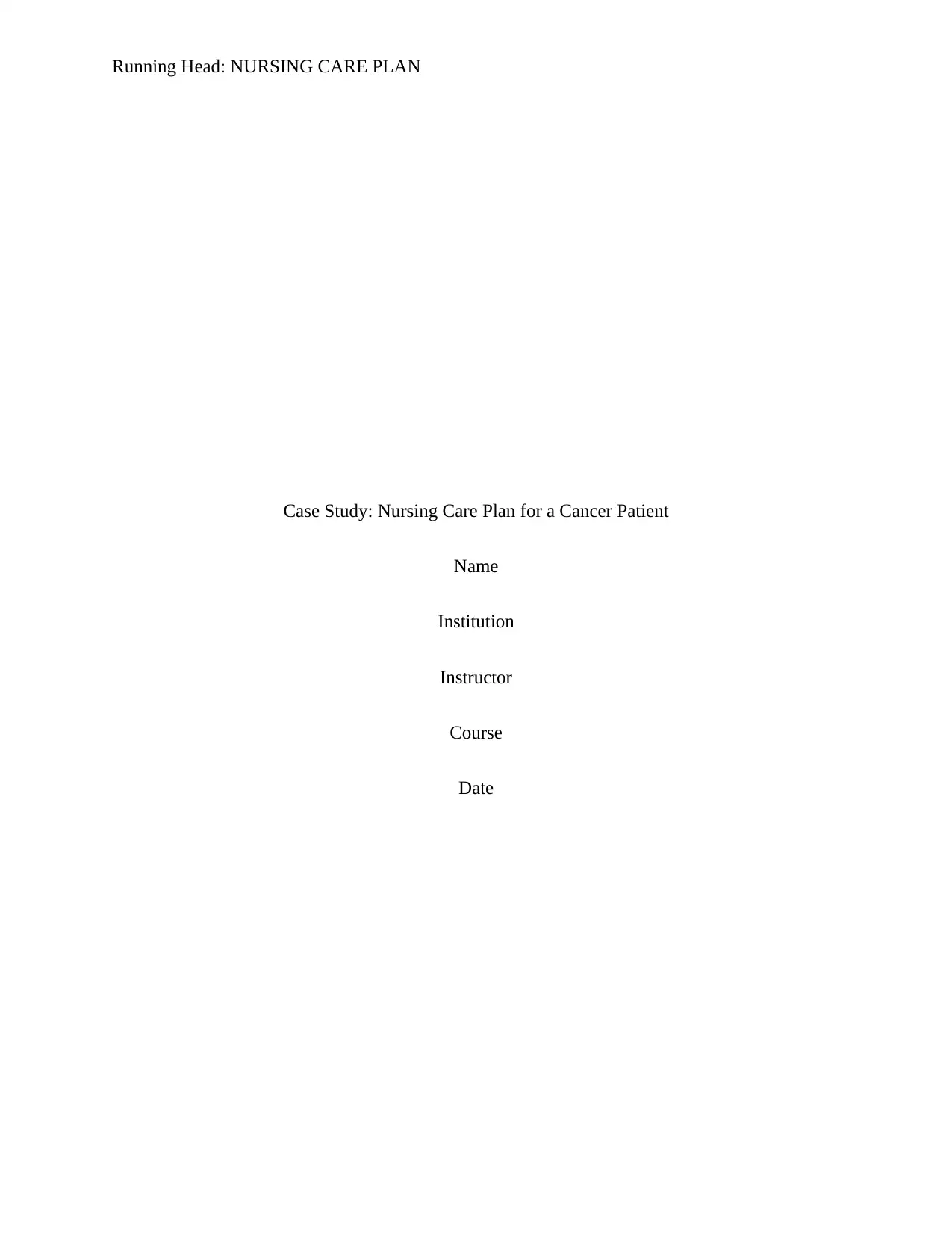
Running Head: NURSING CARE PLAN
Case Study: Nursing Care Plan for a Cancer Patient
Name
Institution
Instructor
Course
Date
Case Study: Nursing Care Plan for a Cancer Patient
Name
Institution
Instructor
Course
Date
Paraphrase This Document
Need a fresh take? Get an instant paraphrase of this document with our AI Paraphraser
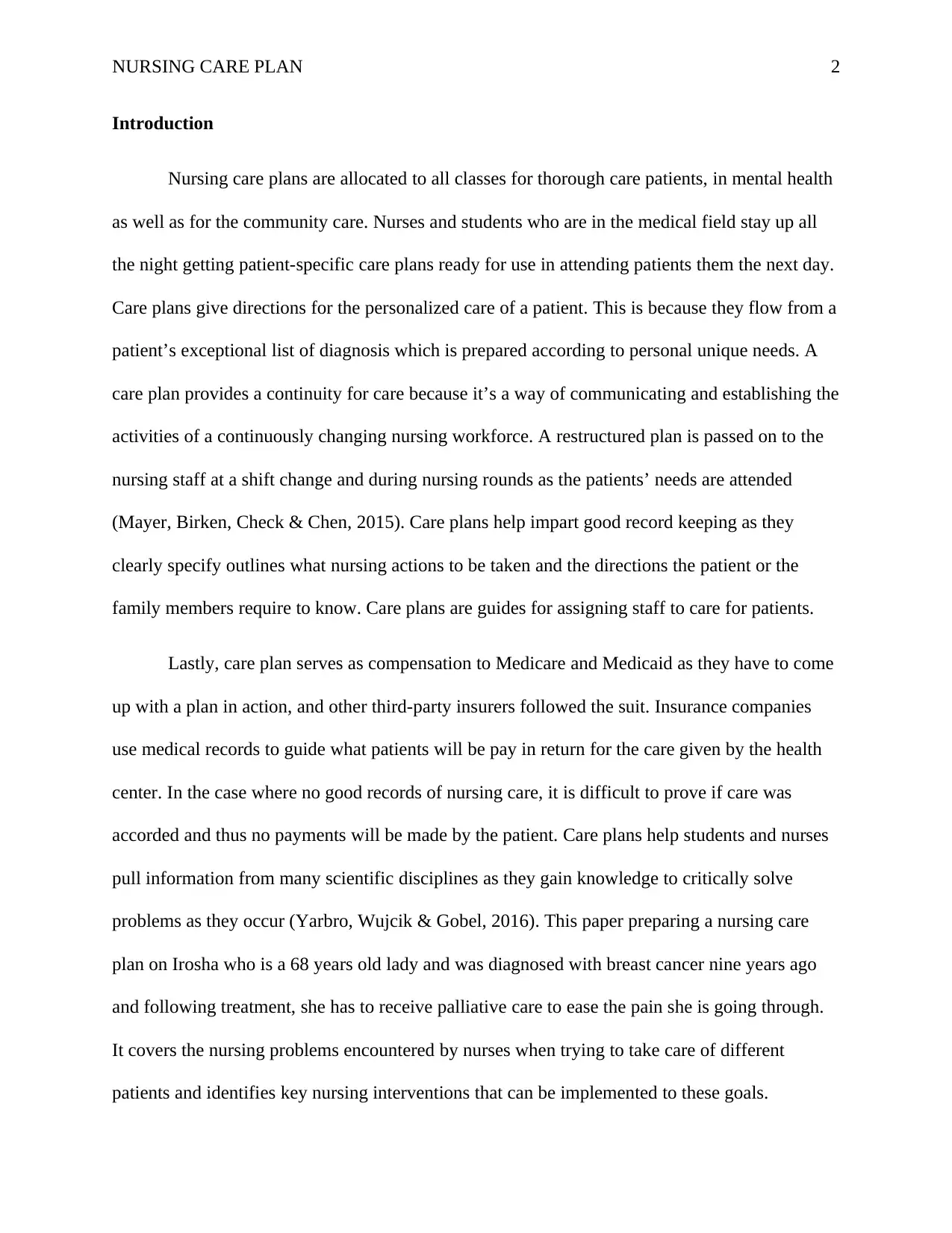
NURSING CARE PLAN 2
Introduction
Nursing care plans are allocated to all classes for thorough care patients, in mental health
as well as for the community care. Nurses and students who are in the medical field stay up all
the night getting patient-specific care plans ready for use in attending patients them the next day.
Care plans give directions for the personalized care of a patient. This is because they flow from a
patient’s exceptional list of diagnosis which is prepared according to personal unique needs. A
care plan provides a continuity for care because it’s a way of communicating and establishing the
activities of a continuously changing nursing workforce. A restructured plan is passed on to the
nursing staff at a shift change and during nursing rounds as the patients’ needs are attended
(Mayer, Birken, Check & Chen, 2015). Care plans help impart good record keeping as they
clearly specify outlines what nursing actions to be taken and the directions the patient or the
family members require to know. Care plans are guides for assigning staff to care for patients.
Lastly, care plan serves as compensation to Medicare and Medicaid as they have to come
up with a plan in action, and other third-party insurers followed the suit. Insurance companies
use medical records to guide what patients will be pay in return for the care given by the health
center. In the case where no good records of nursing care, it is difficult to prove if care was
accorded and thus no payments will be made by the patient. Care plans help students and nurses
pull information from many scientific disciplines as they gain knowledge to critically solve
problems as they occur (Yarbro, Wujcik & Gobel, 2016). This paper preparing a nursing care
plan on Irosha who is a 68 years old lady and was diagnosed with breast cancer nine years ago
and following treatment, she has to receive palliative care to ease the pain she is going through.
It covers the nursing problems encountered by nurses when trying to take care of different
patients and identifies key nursing interventions that can be implemented to these goals.
Introduction
Nursing care plans are allocated to all classes for thorough care patients, in mental health
as well as for the community care. Nurses and students who are in the medical field stay up all
the night getting patient-specific care plans ready for use in attending patients them the next day.
Care plans give directions for the personalized care of a patient. This is because they flow from a
patient’s exceptional list of diagnosis which is prepared according to personal unique needs. A
care plan provides a continuity for care because it’s a way of communicating and establishing the
activities of a continuously changing nursing workforce. A restructured plan is passed on to the
nursing staff at a shift change and during nursing rounds as the patients’ needs are attended
(Mayer, Birken, Check & Chen, 2015). Care plans help impart good record keeping as they
clearly specify outlines what nursing actions to be taken and the directions the patient or the
family members require to know. Care plans are guides for assigning staff to care for patients.
Lastly, care plan serves as compensation to Medicare and Medicaid as they have to come
up with a plan in action, and other third-party insurers followed the suit. Insurance companies
use medical records to guide what patients will be pay in return for the care given by the health
center. In the case where no good records of nursing care, it is difficult to prove if care was
accorded and thus no payments will be made by the patient. Care plans help students and nurses
pull information from many scientific disciplines as they gain knowledge to critically solve
problems as they occur (Yarbro, Wujcik & Gobel, 2016). This paper preparing a nursing care
plan on Irosha who is a 68 years old lady and was diagnosed with breast cancer nine years ago
and following treatment, she has to receive palliative care to ease the pain she is going through.
It covers the nursing problems encountered by nurses when trying to take care of different
patients and identifies key nursing interventions that can be implemented to these goals.
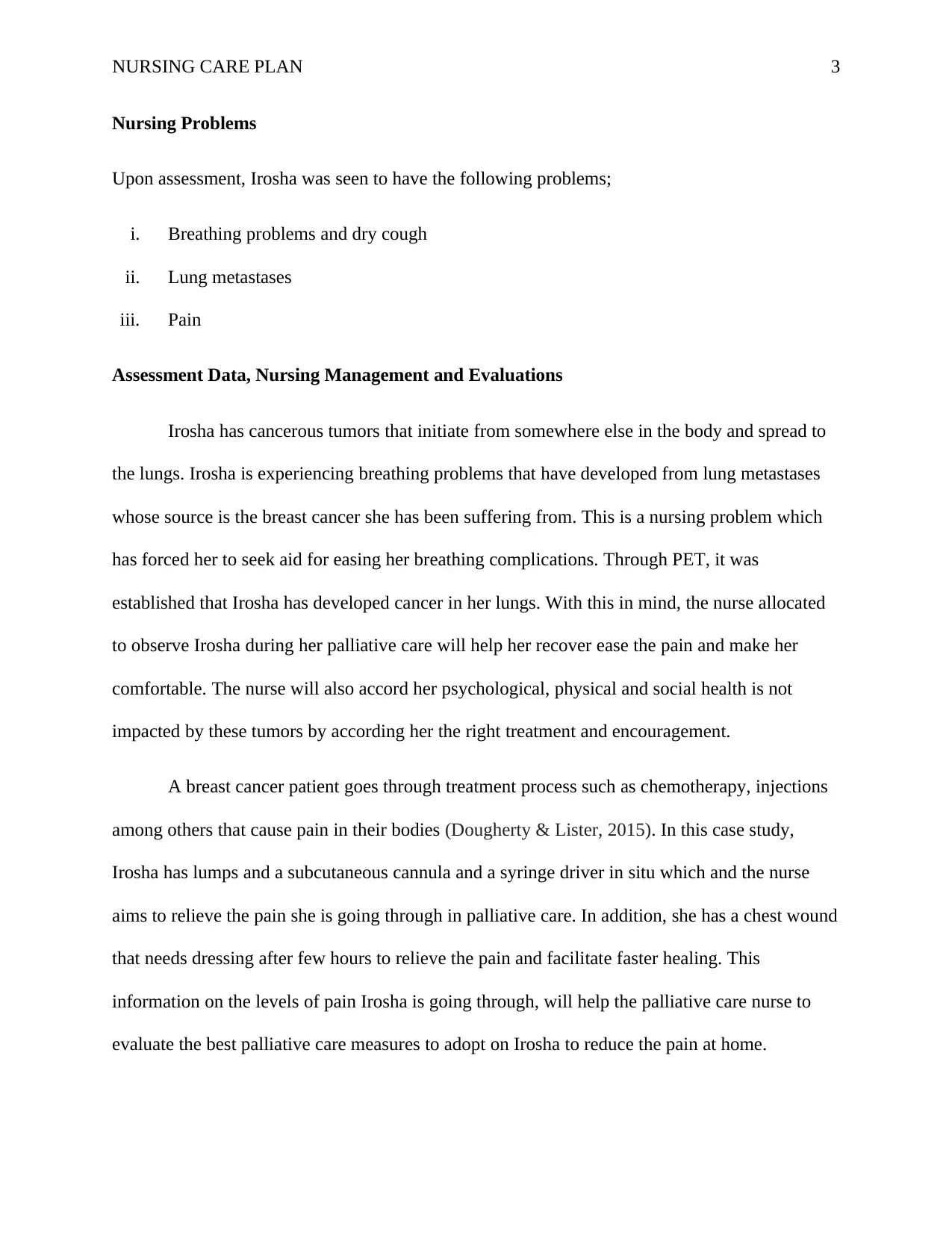
NURSING CARE PLAN 3
Nursing Problems
Upon assessment, Irosha was seen to have the following problems;
i. Breathing problems and dry cough
ii. Lung metastases
iii. Pain
Assessment Data, Nursing Management and Evaluations
Irosha has cancerous tumors that initiate from somewhere else in the body and spread to
the lungs. Irosha is experiencing breathing problems that have developed from lung metastases
whose source is the breast cancer she has been suffering from. This is a nursing problem which
has forced her to seek aid for easing her breathing complications. Through PET, it was
established that Irosha has developed cancer in her lungs. With this in mind, the nurse allocated
to observe Irosha during her palliative care will help her recover ease the pain and make her
comfortable. The nurse will also accord her psychological, physical and social health is not
impacted by these tumors by according her the right treatment and encouragement.
A breast cancer patient goes through treatment process such as chemotherapy, injections
among others that cause pain in their bodies (Dougherty & Lister, 2015). In this case study,
Irosha has lumps and a subcutaneous cannula and a syringe driver in situ which and the nurse
aims to relieve the pain she is going through in palliative care. In addition, she has a chest wound
that needs dressing after few hours to relieve the pain and facilitate faster healing. This
information on the levels of pain Irosha is going through, will help the palliative care nurse to
evaluate the best palliative care measures to adopt on Irosha to reduce the pain at home.
Nursing Problems
Upon assessment, Irosha was seen to have the following problems;
i. Breathing problems and dry cough
ii. Lung metastases
iii. Pain
Assessment Data, Nursing Management and Evaluations
Irosha has cancerous tumors that initiate from somewhere else in the body and spread to
the lungs. Irosha is experiencing breathing problems that have developed from lung metastases
whose source is the breast cancer she has been suffering from. This is a nursing problem which
has forced her to seek aid for easing her breathing complications. Through PET, it was
established that Irosha has developed cancer in her lungs. With this in mind, the nurse allocated
to observe Irosha during her palliative care will help her recover ease the pain and make her
comfortable. The nurse will also accord her psychological, physical and social health is not
impacted by these tumors by according her the right treatment and encouragement.
A breast cancer patient goes through treatment process such as chemotherapy, injections
among others that cause pain in their bodies (Dougherty & Lister, 2015). In this case study,
Irosha has lumps and a subcutaneous cannula and a syringe driver in situ which and the nurse
aims to relieve the pain she is going through in palliative care. In addition, she has a chest wound
that needs dressing after few hours to relieve the pain and facilitate faster healing. This
information on the levels of pain Irosha is going through, will help the palliative care nurse to
evaluate the best palliative care measures to adopt on Irosha to reduce the pain at home.
⊘ This is a preview!⊘
Do you want full access?
Subscribe today to unlock all pages.

Trusted by 1+ million students worldwide
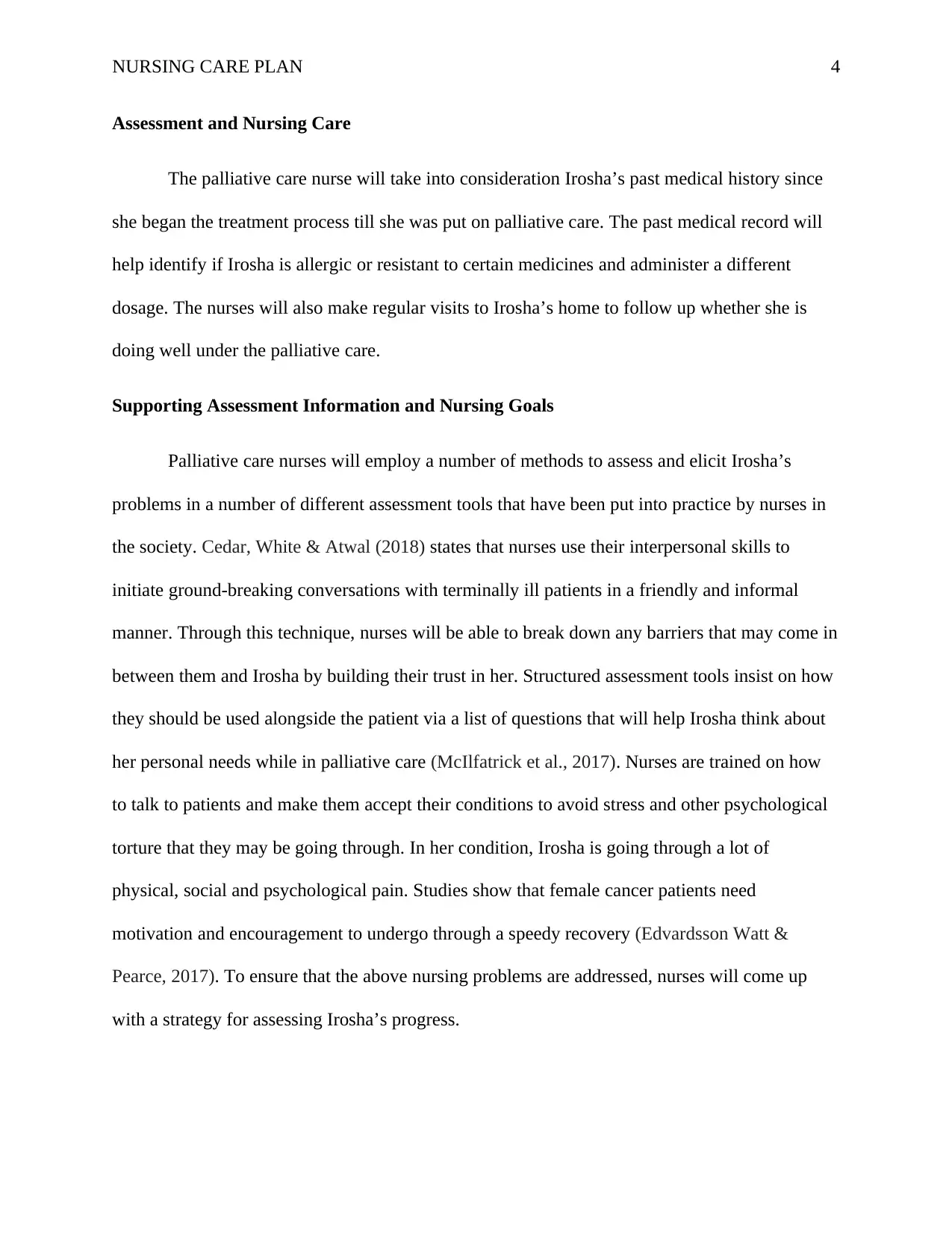
NURSING CARE PLAN 4
Assessment and Nursing Care
The palliative care nurse will take into consideration Irosha’s past medical history since
she began the treatment process till she was put on palliative care. The past medical record will
help identify if Irosha is allergic or resistant to certain medicines and administer a different
dosage. The nurses will also make regular visits to Irosha’s home to follow up whether she is
doing well under the palliative care.
Supporting Assessment Information and Nursing Goals
Palliative care nurses will employ a number of methods to assess and elicit Irosha’s
problems in a number of different assessment tools that have been put into practice by nurses in
the society. Cedar, White & Atwal (2018) states that nurses use their interpersonal skills to
initiate ground-breaking conversations with terminally ill patients in a friendly and informal
manner. Through this technique, nurses will be able to break down any barriers that may come in
between them and Irosha by building their trust in her. Structured assessment tools insist on how
they should be used alongside the patient via a list of questions that will help Irosha think about
her personal needs while in palliative care (McIlfatrick et al., 2017). Nurses are trained on how
to talk to patients and make them accept their conditions to avoid stress and other psychological
torture that they may be going through. In her condition, Irosha is going through a lot of
physical, social and psychological pain. Studies show that female cancer patients need
motivation and encouragement to undergo through a speedy recovery (Edvardsson Watt &
Pearce, 2017). To ensure that the above nursing problems are addressed, nurses will come up
with a strategy for assessing Irosha’s progress.
Assessment and Nursing Care
The palliative care nurse will take into consideration Irosha’s past medical history since
she began the treatment process till she was put on palliative care. The past medical record will
help identify if Irosha is allergic or resistant to certain medicines and administer a different
dosage. The nurses will also make regular visits to Irosha’s home to follow up whether she is
doing well under the palliative care.
Supporting Assessment Information and Nursing Goals
Palliative care nurses will employ a number of methods to assess and elicit Irosha’s
problems in a number of different assessment tools that have been put into practice by nurses in
the society. Cedar, White & Atwal (2018) states that nurses use their interpersonal skills to
initiate ground-breaking conversations with terminally ill patients in a friendly and informal
manner. Through this technique, nurses will be able to break down any barriers that may come in
between them and Irosha by building their trust in her. Structured assessment tools insist on how
they should be used alongside the patient via a list of questions that will help Irosha think about
her personal needs while in palliative care (McIlfatrick et al., 2017). Nurses are trained on how
to talk to patients and make them accept their conditions to avoid stress and other psychological
torture that they may be going through. In her condition, Irosha is going through a lot of
physical, social and psychological pain. Studies show that female cancer patients need
motivation and encouragement to undergo through a speedy recovery (Edvardsson Watt &
Pearce, 2017). To ensure that the above nursing problems are addressed, nurses will come up
with a strategy for assessing Irosha’s progress.
Paraphrase This Document
Need a fresh take? Get an instant paraphrase of this document with our AI Paraphraser
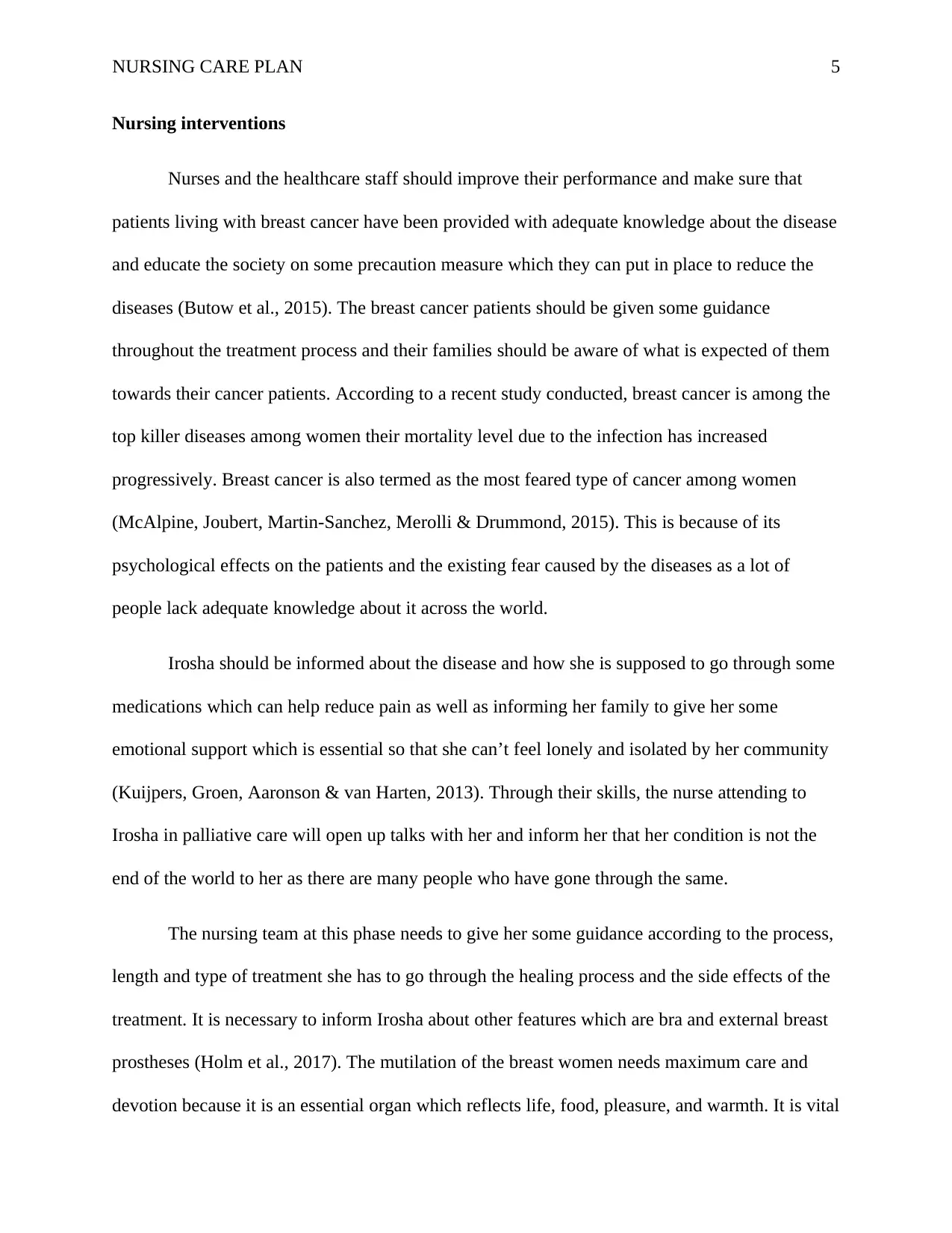
NURSING CARE PLAN 5
Nursing interventions
Nurses and the healthcare staff should improve their performance and make sure that
patients living with breast cancer have been provided with adequate knowledge about the disease
and educate the society on some precaution measure which they can put in place to reduce the
diseases (Butow et al., 2015). The breast cancer patients should be given some guidance
throughout the treatment process and their families should be aware of what is expected of them
towards their cancer patients. According to a recent study conducted, breast cancer is among the
top killer diseases among women their mortality level due to the infection has increased
progressively. Breast cancer is also termed as the most feared type of cancer among women
(McAlpine, Joubert, Martin-Sanchez, Merolli & Drummond, 2015). This is because of its
psychological effects on the patients and the existing fear caused by the diseases as a lot of
people lack adequate knowledge about it across the world.
Irosha should be informed about the disease and how she is supposed to go through some
medications which can help reduce pain as well as informing her family to give her some
emotional support which is essential so that she can’t feel lonely and isolated by her community
(Kuijpers, Groen, Aaronson & van Harten, 2013). Through their skills, the nurse attending to
Irosha in palliative care will open up talks with her and inform her that her condition is not the
end of the world to her as there are many people who have gone through the same.
The nursing team at this phase needs to give her some guidance according to the process,
length and type of treatment she has to go through the healing process and the side effects of the
treatment. It is necessary to inform Irosha about other features which are bra and external breast
prostheses (Holm et al., 2017). The mutilation of the breast women needs maximum care and
devotion because it is an essential organ which reflects life, food, pleasure, and warmth. It is vital
Nursing interventions
Nurses and the healthcare staff should improve their performance and make sure that
patients living with breast cancer have been provided with adequate knowledge about the disease
and educate the society on some precaution measure which they can put in place to reduce the
diseases (Butow et al., 2015). The breast cancer patients should be given some guidance
throughout the treatment process and their families should be aware of what is expected of them
towards their cancer patients. According to a recent study conducted, breast cancer is among the
top killer diseases among women their mortality level due to the infection has increased
progressively. Breast cancer is also termed as the most feared type of cancer among women
(McAlpine, Joubert, Martin-Sanchez, Merolli & Drummond, 2015). This is because of its
psychological effects on the patients and the existing fear caused by the diseases as a lot of
people lack adequate knowledge about it across the world.
Irosha should be informed about the disease and how she is supposed to go through some
medications which can help reduce pain as well as informing her family to give her some
emotional support which is essential so that she can’t feel lonely and isolated by her community
(Kuijpers, Groen, Aaronson & van Harten, 2013). Through their skills, the nurse attending to
Irosha in palliative care will open up talks with her and inform her that her condition is not the
end of the world to her as there are many people who have gone through the same.
The nursing team at this phase needs to give her some guidance according to the process,
length and type of treatment she has to go through the healing process and the side effects of the
treatment. It is necessary to inform Irosha about other features which are bra and external breast
prostheses (Holm et al., 2017). The mutilation of the breast women needs maximum care and
devotion because it is an essential organ which reflects life, food, pleasure, and warmth. It is vital
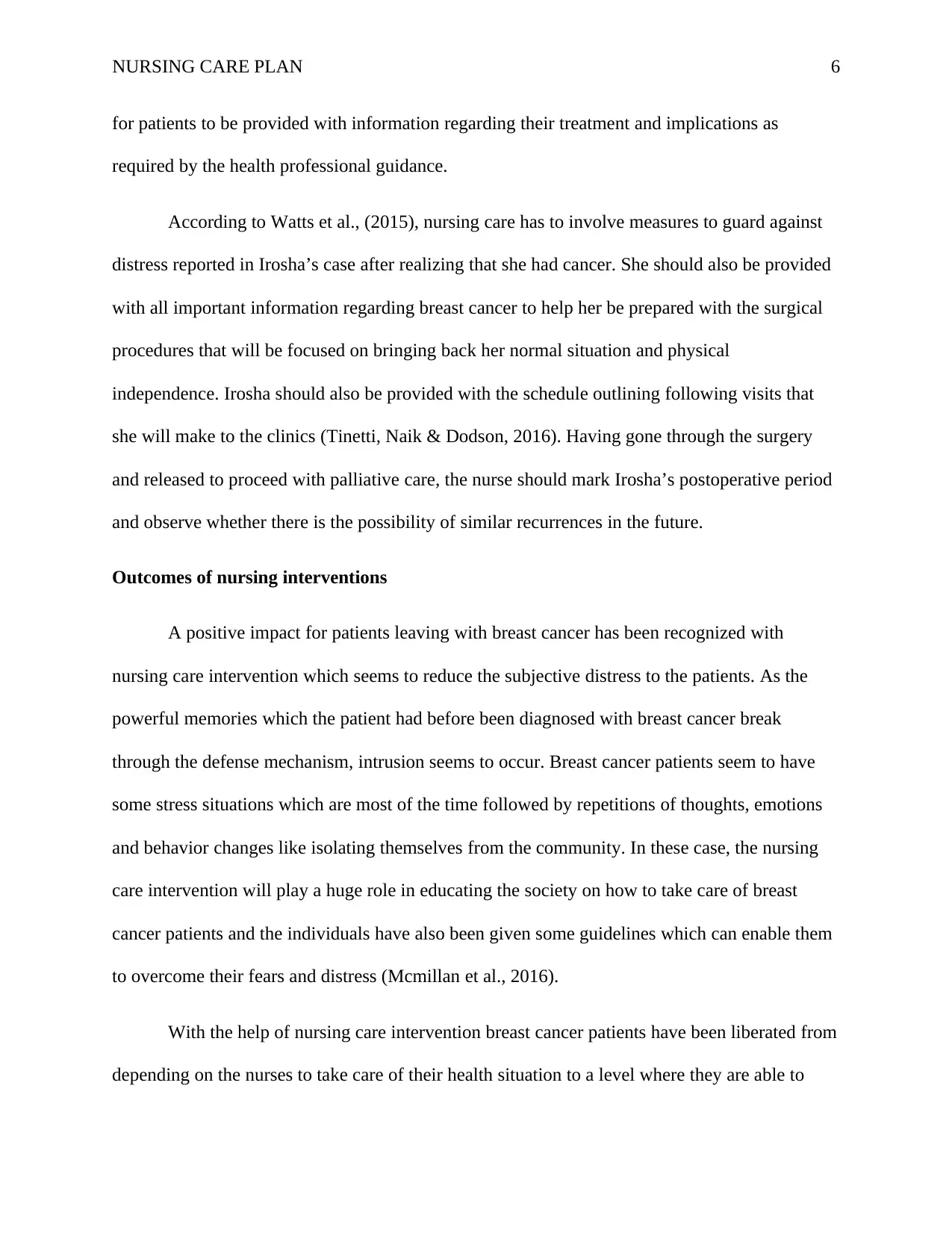
NURSING CARE PLAN 6
for patients to be provided with information regarding their treatment and implications as
required by the health professional guidance.
According to Watts et al., (2015), nursing care has to involve measures to guard against
distress reported in Irosha’s case after realizing that she had cancer. She should also be provided
with all important information regarding breast cancer to help her be prepared with the surgical
procedures that will be focused on bringing back her normal situation and physical
independence. Irosha should also be provided with the schedule outlining following visits that
she will make to the clinics (Tinetti, Naik & Dodson, 2016). Having gone through the surgery
and released to proceed with palliative care, the nurse should mark Irosha’s postoperative period
and observe whether there is the possibility of similar recurrences in the future.
Outcomes of nursing interventions
A positive impact for patients leaving with breast cancer has been recognized with
nursing care intervention which seems to reduce the subjective distress to the patients. As the
powerful memories which the patient had before been diagnosed with breast cancer break
through the defense mechanism, intrusion seems to occur. Breast cancer patients seem to have
some stress situations which are most of the time followed by repetitions of thoughts, emotions
and behavior changes like isolating themselves from the community. In these case, the nursing
care intervention will play a huge role in educating the society on how to take care of breast
cancer patients and the individuals have also been given some guidelines which can enable them
to overcome their fears and distress (Mcmillan et al., 2016).
With the help of nursing care intervention breast cancer patients have been liberated from
depending on the nurses to take care of their health situation to a level where they are able to
for patients to be provided with information regarding their treatment and implications as
required by the health professional guidance.
According to Watts et al., (2015), nursing care has to involve measures to guard against
distress reported in Irosha’s case after realizing that she had cancer. She should also be provided
with all important information regarding breast cancer to help her be prepared with the surgical
procedures that will be focused on bringing back her normal situation and physical
independence. Irosha should also be provided with the schedule outlining following visits that
she will make to the clinics (Tinetti, Naik & Dodson, 2016). Having gone through the surgery
and released to proceed with palliative care, the nurse should mark Irosha’s postoperative period
and observe whether there is the possibility of similar recurrences in the future.
Outcomes of nursing interventions
A positive impact for patients leaving with breast cancer has been recognized with
nursing care intervention which seems to reduce the subjective distress to the patients. As the
powerful memories which the patient had before been diagnosed with breast cancer break
through the defense mechanism, intrusion seems to occur. Breast cancer patients seem to have
some stress situations which are most of the time followed by repetitions of thoughts, emotions
and behavior changes like isolating themselves from the community. In these case, the nursing
care intervention will play a huge role in educating the society on how to take care of breast
cancer patients and the individuals have also been given some guidelines which can enable them
to overcome their fears and distress (Mcmillan et al., 2016).
With the help of nursing care intervention breast cancer patients have been liberated from
depending on the nurses to take care of their health situation to a level where they are able to
⊘ This is a preview!⊘
Do you want full access?
Subscribe today to unlock all pages.

Trusted by 1+ million students worldwide
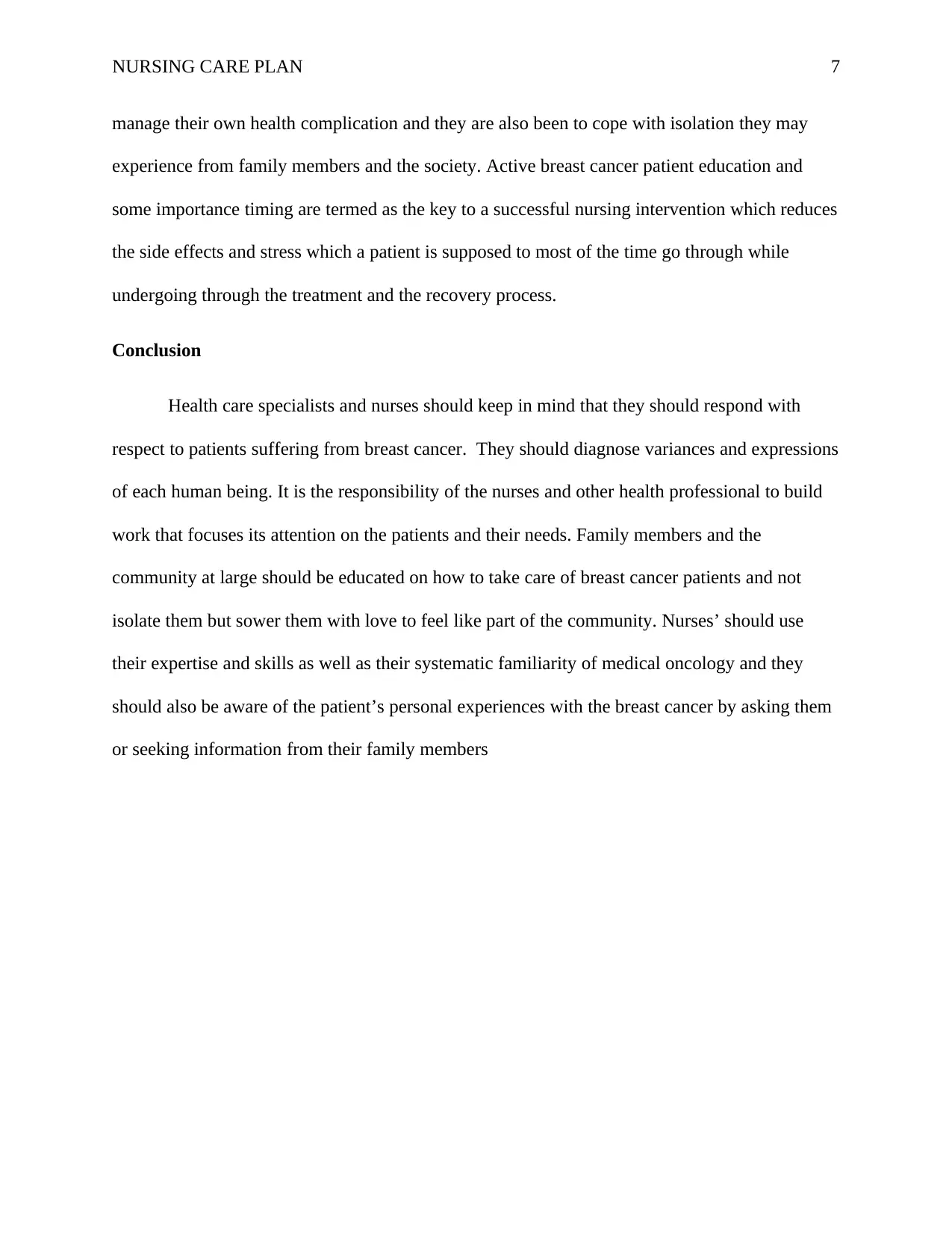
NURSING CARE PLAN 7
manage their own health complication and they are also been to cope with isolation they may
experience from family members and the society. Active breast cancer patient education and
some importance timing are termed as the key to a successful nursing intervention which reduces
the side effects and stress which a patient is supposed to most of the time go through while
undergoing through the treatment and the recovery process.
Conclusion
Health care specialists and nurses should keep in mind that they should respond with
respect to patients suffering from breast cancer. They should diagnose variances and expressions
of each human being. It is the responsibility of the nurses and other health professional to build
work that focuses its attention on the patients and their needs. Family members and the
community at large should be educated on how to take care of breast cancer patients and not
isolate them but sower them with love to feel like part of the community. Nurses’ should use
their expertise and skills as well as their systematic familiarity of medical oncology and they
should also be aware of the patient’s personal experiences with the breast cancer by asking them
or seeking information from their family members
manage their own health complication and they are also been to cope with isolation they may
experience from family members and the society. Active breast cancer patient education and
some importance timing are termed as the key to a successful nursing intervention which reduces
the side effects and stress which a patient is supposed to most of the time go through while
undergoing through the treatment and the recovery process.
Conclusion
Health care specialists and nurses should keep in mind that they should respond with
respect to patients suffering from breast cancer. They should diagnose variances and expressions
of each human being. It is the responsibility of the nurses and other health professional to build
work that focuses its attention on the patients and their needs. Family members and the
community at large should be educated on how to take care of breast cancer patients and not
isolate them but sower them with love to feel like part of the community. Nurses’ should use
their expertise and skills as well as their systematic familiarity of medical oncology and they
should also be aware of the patient’s personal experiences with the breast cancer by asking them
or seeking information from their family members
Paraphrase This Document
Need a fresh take? Get an instant paraphrase of this document with our AI Paraphraser
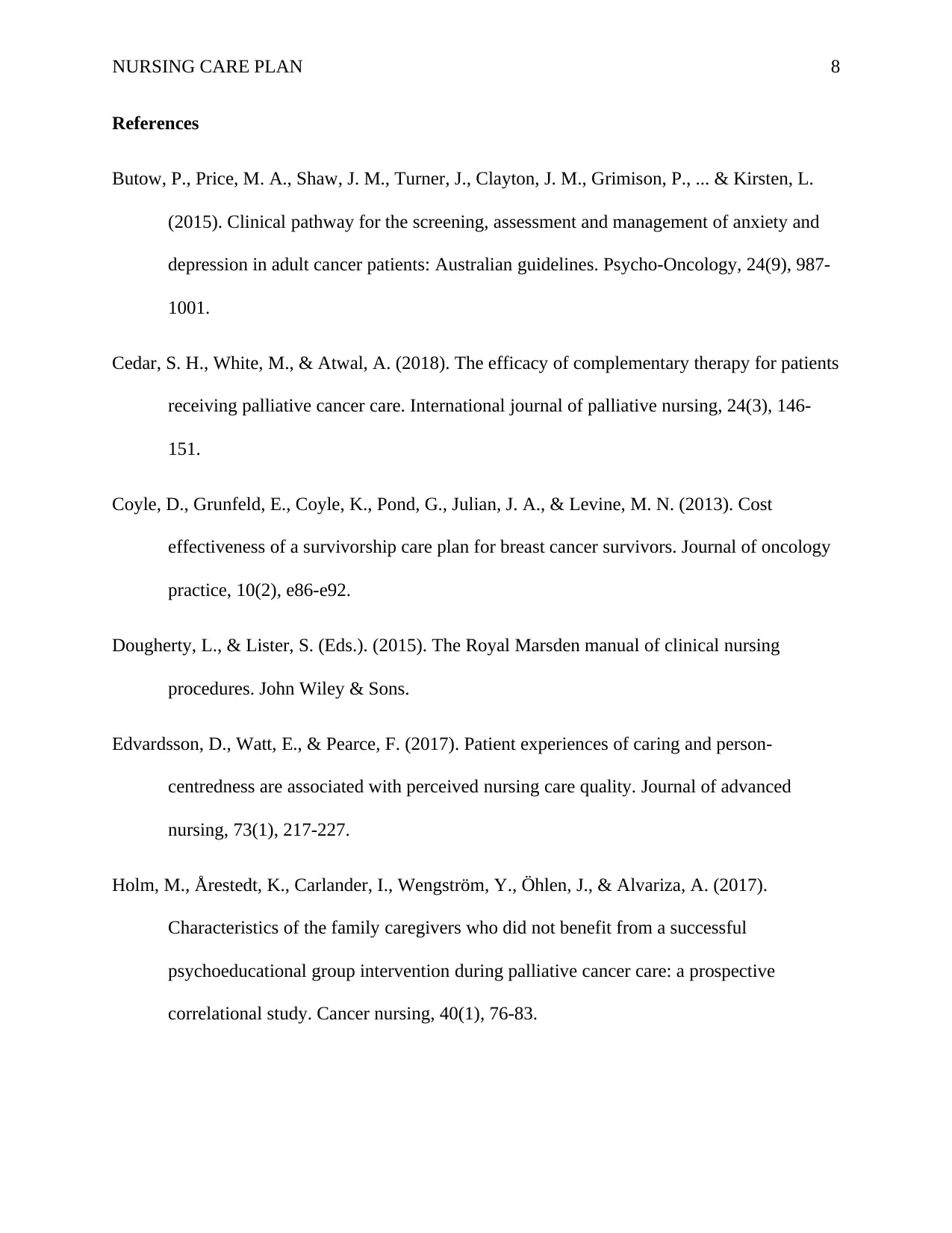
NURSING CARE PLAN 8
References
Butow, P., Price, M. A., Shaw, J. M., Turner, J., Clayton, J. M., Grimison, P., ... & Kirsten, L.
(2015). Clinical pathway for the screening, assessment and management of anxiety and
depression in adult cancer patients: Australian guidelines. Psycho‐Oncology, 24(9), 987-
1001.
Cedar, S. H., White, M., & Atwal, A. (2018). The efficacy of complementary therapy for patients
receiving palliative cancer care. International journal of palliative nursing, 24(3), 146-
151.
Coyle, D., Grunfeld, E., Coyle, K., Pond, G., Julian, J. A., & Levine, M. N. (2013). Cost
effectiveness of a survivorship care plan for breast cancer survivors. Journal of oncology
practice, 10(2), e86-e92.
Dougherty, L., & Lister, S. (Eds.). (2015). The Royal Marsden manual of clinical nursing
procedures. John Wiley & Sons.
Edvardsson, D., Watt, E., & Pearce, F. (2017). Patient experiences of caring and person‐
centredness are associated with perceived nursing care quality. Journal of advanced
nursing, 73(1), 217-227.
Holm, M., Årestedt, K., Carlander, I., Wengström, Y., Öhlen, J., & Alvariza, A. (2017).
Characteristics of the family caregivers who did not benefit from a successful
psychoeducational group intervention during palliative cancer care: a prospective
correlational study. Cancer nursing, 40(1), 76-83.
References
Butow, P., Price, M. A., Shaw, J. M., Turner, J., Clayton, J. M., Grimison, P., ... & Kirsten, L.
(2015). Clinical pathway for the screening, assessment and management of anxiety and
depression in adult cancer patients: Australian guidelines. Psycho‐Oncology, 24(9), 987-
1001.
Cedar, S. H., White, M., & Atwal, A. (2018). The efficacy of complementary therapy for patients
receiving palliative cancer care. International journal of palliative nursing, 24(3), 146-
151.
Coyle, D., Grunfeld, E., Coyle, K., Pond, G., Julian, J. A., & Levine, M. N. (2013). Cost
effectiveness of a survivorship care plan for breast cancer survivors. Journal of oncology
practice, 10(2), e86-e92.
Dougherty, L., & Lister, S. (Eds.). (2015). The Royal Marsden manual of clinical nursing
procedures. John Wiley & Sons.
Edvardsson, D., Watt, E., & Pearce, F. (2017). Patient experiences of caring and person‐
centredness are associated with perceived nursing care quality. Journal of advanced
nursing, 73(1), 217-227.
Holm, M., Årestedt, K., Carlander, I., Wengström, Y., Öhlen, J., & Alvariza, A. (2017).
Characteristics of the family caregivers who did not benefit from a successful
psychoeducational group intervention during palliative cancer care: a prospective
correlational study. Cancer nursing, 40(1), 76-83.
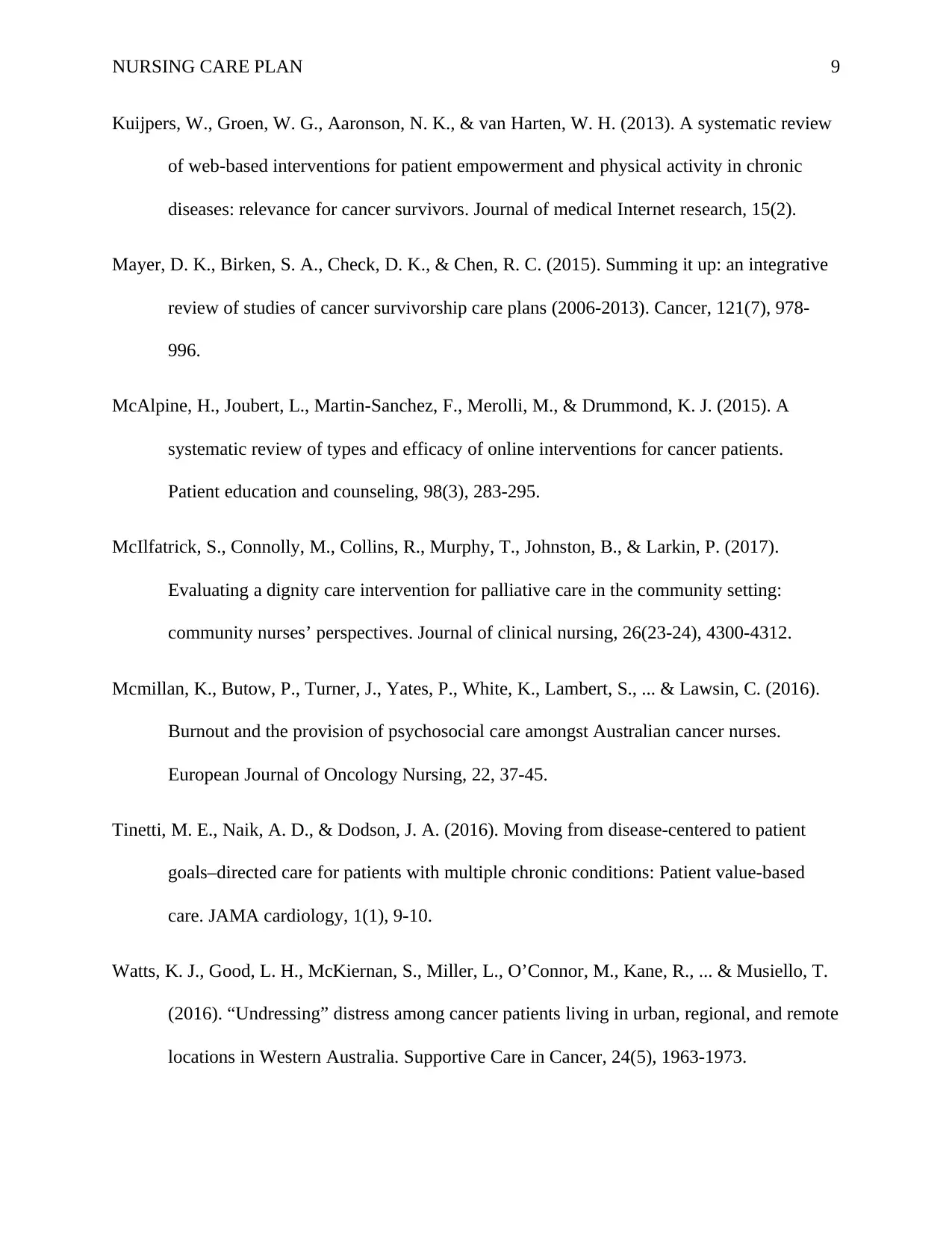
NURSING CARE PLAN 9
Kuijpers, W., Groen, W. G., Aaronson, N. K., & van Harten, W. H. (2013). A systematic review
of web-based interventions for patient empowerment and physical activity in chronic
diseases: relevance for cancer survivors. Journal of medical Internet research, 15(2).
Mayer, D. K., Birken, S. A., Check, D. K., & Chen, R. C. (2015). Summing it up: an integrative
review of studies of cancer survivorship care plans (2006‐2013). Cancer, 121(7), 978-
996.
McAlpine, H., Joubert, L., Martin-Sanchez, F., Merolli, M., & Drummond, K. J. (2015). A
systematic review of types and efficacy of online interventions for cancer patients.
Patient education and counseling, 98(3), 283-295.
McIlfatrick, S., Connolly, M., Collins, R., Murphy, T., Johnston, B., & Larkin, P. (2017).
Evaluating a dignity care intervention for palliative care in the community setting:
community nurses’ perspectives. Journal of clinical nursing, 26(23-24), 4300-4312.
Mcmillan, K., Butow, P., Turner, J., Yates, P., White, K., Lambert, S., ... & Lawsin, C. (2016).
Burnout and the provision of psychosocial care amongst Australian cancer nurses.
European Journal of Oncology Nursing, 22, 37-45.
Tinetti, M. E., Naik, A. D., & Dodson, J. A. (2016). Moving from disease-centered to patient
goals–directed care for patients with multiple chronic conditions: Patient value-based
care. JAMA cardiology, 1(1), 9-10.
Watts, K. J., Good, L. H., McKiernan, S., Miller, L., O’Connor, M., Kane, R., ... & Musiello, T.
(2016). “Undressing” distress among cancer patients living in urban, regional, and remote
locations in Western Australia. Supportive Care in Cancer, 24(5), 1963-1973.
Kuijpers, W., Groen, W. G., Aaronson, N. K., & van Harten, W. H. (2013). A systematic review
of web-based interventions for patient empowerment and physical activity in chronic
diseases: relevance for cancer survivors. Journal of medical Internet research, 15(2).
Mayer, D. K., Birken, S. A., Check, D. K., & Chen, R. C. (2015). Summing it up: an integrative
review of studies of cancer survivorship care plans (2006‐2013). Cancer, 121(7), 978-
996.
McAlpine, H., Joubert, L., Martin-Sanchez, F., Merolli, M., & Drummond, K. J. (2015). A
systematic review of types and efficacy of online interventions for cancer patients.
Patient education and counseling, 98(3), 283-295.
McIlfatrick, S., Connolly, M., Collins, R., Murphy, T., Johnston, B., & Larkin, P. (2017).
Evaluating a dignity care intervention for palliative care in the community setting:
community nurses’ perspectives. Journal of clinical nursing, 26(23-24), 4300-4312.
Mcmillan, K., Butow, P., Turner, J., Yates, P., White, K., Lambert, S., ... & Lawsin, C. (2016).
Burnout and the provision of psychosocial care amongst Australian cancer nurses.
European Journal of Oncology Nursing, 22, 37-45.
Tinetti, M. E., Naik, A. D., & Dodson, J. A. (2016). Moving from disease-centered to patient
goals–directed care for patients with multiple chronic conditions: Patient value-based
care. JAMA cardiology, 1(1), 9-10.
Watts, K. J., Good, L. H., McKiernan, S., Miller, L., O’Connor, M., Kane, R., ... & Musiello, T.
(2016). “Undressing” distress among cancer patients living in urban, regional, and remote
locations in Western Australia. Supportive Care in Cancer, 24(5), 1963-1973.
⊘ This is a preview!⊘
Do you want full access?
Subscribe today to unlock all pages.

Trusted by 1+ million students worldwide

NURSING CARE PLAN 10
Yarbro, C. H., Wujcik, D., & Gobel, B. H. (2016). Cancer nursing. Jones & Bartlett Publishers.
Yarbro, C. H., Wujcik, D., & Gobel, B. H. (2016). Cancer nursing. Jones & Bartlett Publishers.
1 out of 10
Related Documents
Your All-in-One AI-Powered Toolkit for Academic Success.
+13062052269
info@desklib.com
Available 24*7 on WhatsApp / Email
![[object Object]](/_next/static/media/star-bottom.7253800d.svg)
Unlock your academic potential
Copyright © 2020–2025 A2Z Services. All Rights Reserved. Developed and managed by ZUCOL.





